Slow it Down, Soak it in: Conserving Rainwater with Downspout Disconnection

When it rains in July and August, we are almost always thankful for the moisture. And yet this valuable resource is often directed off of properties and out of town as quickly as possible via downspouts and storm drains.
Stormwater runoff is rainwater that does not soak into the ground. It flows from rooftops, streets, parking lots, sidewalks, driveways, bare soil, sloped lawns, and other areas.
As it flows, this runoff collects and transports soil particles, fertilizer, pesticides, oil and grease, metals, bacteria, leaves and grass clippings, litter, animal wastes, and other pollutants.
Stormwater runoff that drains into storm drains (storm sewers) is rapidly conveyed to a nearby stream, river, or other water body. Unlike sanitary sewers, most water from storm drains is not treated at a wastewater treatment plant; instead it flows directly to a water body taking pollutants with it.
Disconnecting downspouts and impervious surfaces is one thing individuals can do to reduce the amount of water leaving their property and the pollutants that go with it.
Downspout disconnection is redirecting water from downspouts to a pervious area where more water can soak into soil. Disconnection helps ensure that rainwater runoff does not have a direct route to a storm drain or water body.
Instead, runoff is directed to one or more of the following: a rainwater harvesting system where it is temporarily stored for later use; a specifically designed pervious area where it infiltrates into soil; or across a vegetated surface, like a lawn, where it is filtered prior to reaching a water body.
Simply redirecting a downspout so it discharges onto a lawn, mulched shrub bed, or other planted area instead of an impervious surface such as a driveway can greatly reduce the amount of rainwater and pollutants that leave a property and reach a water body. By slowing down and soaking in rainwater where it lands, water is conserved and runoff pollution decreased.
Besides the filtering benefits of the runoff flowing through landscape vegetation, additional benefits are gained from the runoff infiltrating into soil.
However, it is preferable if the runoff water can be directed to a designed rainwater harvesting system where it is collected and used or allowed to infiltrate under controlled conditions.
Such systems range from rain barrels and cisterns to permeable paving to rain gardens, bioswales, bioretention gardens and much more.
To learn about downspout redirection, refer to Nebraska Extension NebGuide G2186 Disconnecting Downspouts and Impervious Surfaces at https://extensionpublications.unl.edu/assets/pdf/g2186.pdf.
For descriptions of rainwater harvesting systems, refer to NebGuide G2148, Stormwater Management: Rainwater Harvesting in Residential Landscapes https://extensionpublications.unl.edu/assets/pdf/g2148.pdf
Increasing knowledge about ways to slow down and soak in rainwater helps make wise use of water, valuable natural resource, rather than treating it as a waste product to get rid of as quickly as possible.
Source: Disconnecting Downspouts and Impervious Surfaces G2186 NebGuide
This article was reviewed by Katie Pekarek